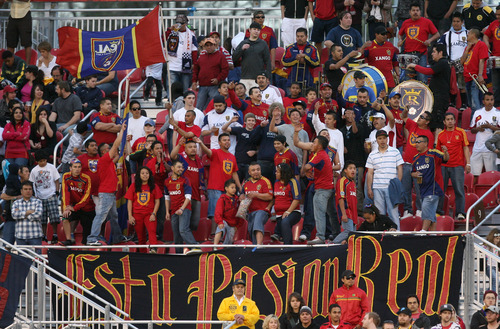This is an archived article that was published on sltrib.com in 2012, and information in the article may be outdated. It is provided only for personal research purposes and may not be reprinted.
Sandy • By almost any measurement, attendance for Real Salt Lake games has skyrocketed in 2012.
RSL president Bill Manning understood the exact moment when he knew that the franchise turned the corner — when 17,000 fans paid to see RSL play a minor league team in U.S. Open Cup competition in May.
"I said, 'We've got something going,' " Manning remembered. "The least of my worries now is attendance."
Manning can sit back and enjoy record fan numbers, including eight sellouts so far at Rio Tinto Stadium this season — with the promise of the same for the final four home dates before the start of the Major League Soccer playoffs, including Saturday's 7 p.m. game against D.C. United.
So far, average attendance at Rio Tinto Stadium is 93 percent of its 20,008 capacity, which mirrors, for the most part, a league-wide trend. In 2011, MLS enjoyed the third-highest attendance among U.S.-based professional leagues.
"We're killing it, we really are," Manning said of RSL. "We don't even look at the [Utah] Jazz schedule anymore when we make our schedule. We don't even look at BYU or Utah anymore. We've found we can still sell out when they do."
It's not that RSL has stolen from the sports pie formerly shared by Utah's NBA team or the state's two prominent college football programs. Simply put, the pie has gotten larger.
A younger demographic, between ages 18 and 30, has discovered professional soccer in Utah. And the numbers show they like it.
"We've become their team," Manning said.
Part of it is the winning. Since 2008, RSL has become one of the most successful teams in the 19-team league, with an MLS Cup victory in 2009.
And RSL has helped in growing the league.
"Salt Lake has become an important part of the North American soccer landscape, and a market for that is regularly hosting key international soccer events such as the MLS All-Star Game, World Cup qualifying matches and CONCACAF events," said MLS president Mark Abbott. "The stadium is one of the finest soccer venues of its size, and RSL supporters provide an environment that often rivals great soccer crowds throughout the world.
"We had great faith in Salt Lake City, and the market has certainly delivered. We also have great owners in Dave Checketts and Del Loy Hansen."
By season's end, average attendance at energetic, noisy Rio Tinto sometimes will be at or near 19,000 — a 10 percent jump from last season, which follows a 7.4 percent increase from 2010.
In fact, RSL attendance has increased each season since 2008. Don't think the players haven't noticed.
"It's huge," RSL coach Jason Kreis said. "I continue to believe they are a big part of every success we've had here at Rio Tinto Stadium. It feels like a big surge when they're singing the [team] song. … It's awesome."
Certainly, the move in October 2008 from Rice-Eccles Stadium to soccer-specific Rio Tinto has been a big reason. Manning acknowledges that in the early years, beginning in 2005, Real "salted" the team's attendance numbers by offering free tickets, up to 30 percent worth.
Since then, the team has created a department that strictly caters to season-ticket holders. It has worked. Season-ticket holders have increased by more than 50 percent since 2005 and Manning predicts the franchise will approach 10,000 season tickets sold for 2013.
"What we compete for is media," Manning said. "You guys are torn all over the place."
Media is the one hurdle remaining for RSL and the league. The MLS moved its television contract from Fox to NBC starting this season. And while the numbers are better overall, viewership remains negligible. According to the Nielsen ratings, six of the past seven MLS games on NBCSN have drawn an average audience of only about 200,000 viewers. Locally, it is only a bit better for games on CW30 or Ch. 4.
But one step at a time.
"This year, we've made a quantum leap," Manning said of RSL's attendance. "The fan base has just reacted. Our fans really want to see the team succeed. They're part of our fabric now. There is a good vibe right now.
"Now, it's just figuring out how to keep the team on track."
Twitter: @rsltribune —
RSL's average yearly attendance
2005 • 18,030
2006 • 16,366
2007 • 15,960
2008 • 16,179
2009 • 16,375
2010 • 17,095
2011 • 17,591
2012 • 18,794
Note: RSL moved from Rice-Eccles Stadium to Rio Tinto Stadium in October 2008 —
RSL attendance records
20,762 • Largest soccer crowd at Rio Tinto Stadium (Sept. 28, 2011 vs. Chicago Fire)
45,511 • Largest soccer crowd at Rice-Eccles Stadium (Aug. 12, 2006 vs. Real Madrid) —
MSL attendance averages
Through Aug. 26:
Team Total Average
Seattle 511,316 42,609
Montreal 346,605 23,107
L.A. 271,947 22,662
Houston 272,378 20,952
Portland 265,694 20,438
Vancouver 252,312 19,408
K.C. 251,078 19,313
Toronto 246,906 18,992
RSL 263,117 18,794
Phil. 221,034 18,419
New York 211,969 17,664
Chicago 188,685 15,723
Colorado 196,552 15,119
Columbus 174,445 14,537
San Jose 184,087 14,160
FC Dallas 195,089 13,934
DC United 178,558 13,735
Chivas USA 174,675 13,436
New Eng. 154,996 12,916
Source: Soccernet.ESPN —
RSL vs. D.C. United
P Saturday, 7 p.m.
Rio Tinto Stadium
TV • CW30



